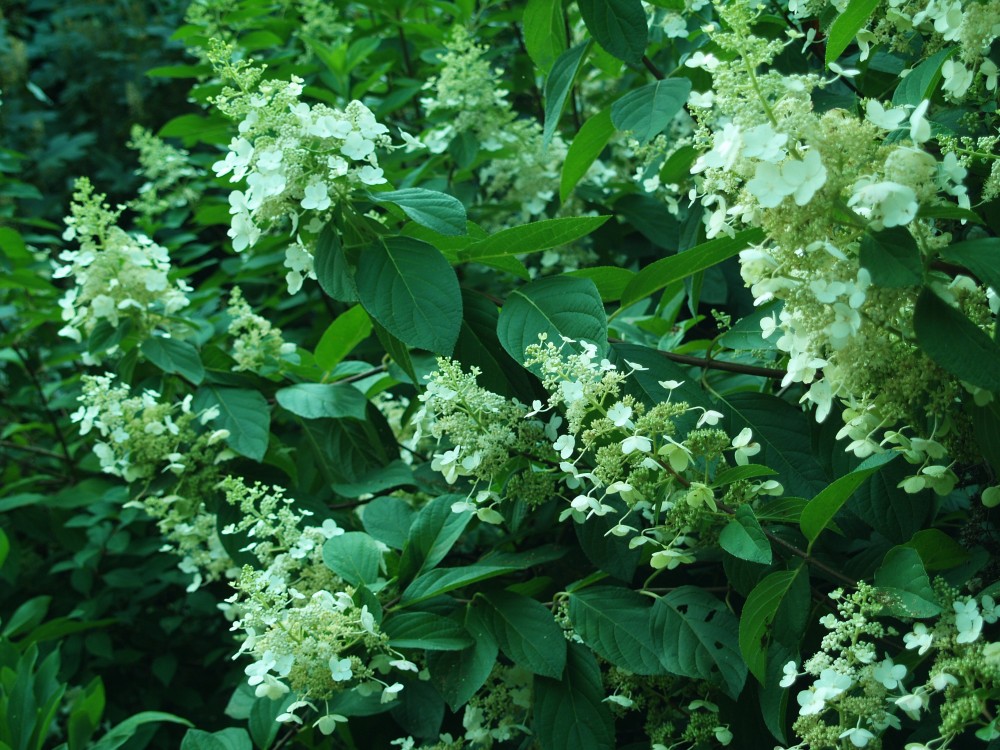A seedling of Tardiva hydrangea (Hydrangea paniculata ‘Tardiva’, below) has popped up in the middle of the lacecap ‘Twist-n-Shout’ (Hydrangea macrophylla ‘Twist-n-Shout’) . ‘Tardiva’ is a cultivar, so it’s unlikely that the seedling will be identical to the parent plant, but it appears to be very close in appearance. The more pertinent question is, should the seedling be allowed to grow up through the other hydrangea, since panicled hydrangeas grow many time larger than mopheads so that the smaller plant will quickly be overwhelmed?
Of course, there is no sense in leaving both hydrangeas, and since the parent ‘Tardiva’ is only a few feet away it makes perfect sense to pluck the seedling out. But … as the seedling grew up through the lacecap it was shaded so there are no branches for the first few feet. Then the main stem divides into three, and there are flowers on each of them that stand about four feet tall.
Panicled hydrangeas are easily made into small trees, so I’ve considered growing the seedling as a small tree with the lacecap growing at its base. I know, the idea is ludicrous! The seedling will grow and flop over the smaller hydrangea, which will be lost. But, I’ve done stupider things. Lots of times! So, I’ll let it go for a year. If it blows up and the lacecap is lost you can be certain never to hear about it again, but if this turns to something remarkable …. Anyway, I’ll probably cut it out in the spring, and of course it will be best if it’s removed long before the roots are hopelessly intertwined with the lacecap’s.
As I’ve said, panicled hydrangeas grow quite large, to nearly ten feet tall and wide, and they are to be treasured because one large shrub will have hundreds of large, creamy white blooms. I planted ‘Tardiva’ a number of years ago, but in recent years there have been a number of superior introductions, notably the chartreuse flowered ‘Limelight’ that fades to white. The flowers of panicled hydrangeas are effective for a month or longer, and blooms that persist through the winter are still somewhat ornamental.
Unfortunately, I’ve planted ‘Limelight’ so that it is barely visible from anywhere else in the garden unless you are to muddle through the swampy overflow of the dirt bottom, wet weather pond at the back of the garden, and then duck under the low hanging branches of the river birch (the one with leaves being eaten by sawfly larvae). Panicled hydrangeas prefer full sunlight, but this one is shaded and squeezed by larger trees, and no matter how vigorous it will eventually lose out to the huge bald cypresses and another river birch planted only a few feet away.
I’ve run out of excuses for today on why I plant things where they don’t belong, so we’ll just say that I planted these when I was young and dumb, and we’ll pretend for a few paragraphs that I don’t do those kind of things anymore. If I had to start things over I would plant a hedge of the various panicled hydrangeas along one one sunny border or the other, at least four or five plants each of three or four cultivars. The shrubs would provide only a minimal screen though the winter and early spring, but the foliage is pleasant, and when flowers arrived in midsummer the sight would be quite splendid for several months.
But, I have no intention to bulldoze the rear garden and start over, and what’s there instead is still quite wonderful without fifteen or twenty hydrangeas with thousands of creamy white flowers. Still, I’ve done stupider things.
I simply love hydrangeas.
Any recommendations on pruning hydrangeas? Timing? Severity?
The timing to prune hydrangeas depends on the type of hydrangea. The paniculata varieties flower on new wood, so they can be pruned late in the autumn or in the spring.
Older mophead varieties (Hydrangea macrophylla) must be pruned immediately after flowering, though even then some buds for the following year might be removed. If a mophead is becoming too large it is best to prune select branches over several years so that flowers are not sacrificed, though many people say the heck with it and cut it back severely, knowing that they’ll have no flowers for the following year.
Newer mophead varieties such as Endless Summer and Penny Mac flower on both old and new wood, so if branch tips are damaged by winter’s cold or they are pruned, they will still flower. Many of these are also repeat bloomers so that the first flowers are in late spring and then scattered through summer into autumn. In my garden I get two major periods of flowers, late May into June, and mid to late September into late October.
In years when mophead hydrangeas die back from winter cold I’ve cut them nearly to the ground and they grow back to full size by mid spring, so there’s no problem in cutting a hydrangea back as far as you’d like.